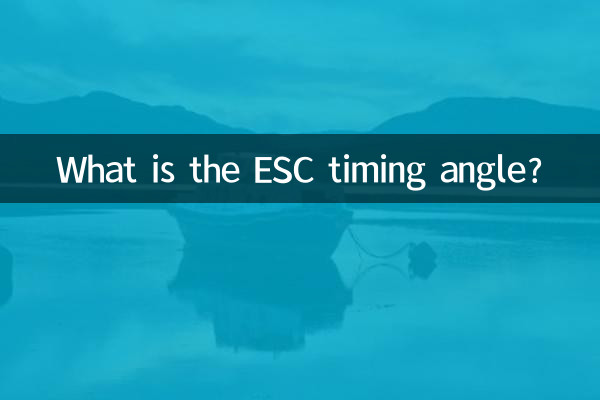What is the ESC timing angle?
In recent years, with the popularity of electric vehicles and drones, ESC (electronic speed regulator) related technologies have also become a hot topic. Among them, "electrical control advance angle" is a key parameter, but many users do not understand it deeply enough. This article will combine the hot content on the entire network in the past 10 days to provide a detailed analysis of the definition, function and practical application of electronic timing angle.
1. Definition of ESC timing angle

Timing Advance refers to the time angle at which the phase current is triggered in advance when the ESC controls the brushless motor. Simply put, it is the phase angle at which the ESC energizes the motor in advance before the motor rotor reaches the ideal position. The setting of the timing angle directly affects the efficiency, torque and heat generation of the motor.
2. The function of ESC timing angle
The main functions of ESC timing include:
1.Improve motor efficiency: By optimizing the timing angle, energy loss can be reduced and the output efficiency of the motor can be improved.
2.Enhanced torque: An appropriate timing angle can increase the starting torque of the motor, especially at low speeds.
3.Reduce fever: Improper setting of the timing angle will cause the motor to overheat. A reasonable timing angle can balance performance and heat generation.
3. The relationship between hot topics on the Internet in the past 10 days and ESC timing
Through the analysis of hot content on the entire network in the past 10 days, we found that ESC timing is frequently discussed in the following areas:
| field | Discussion hot spots | Relationship with ESC timing angle |
|---|---|---|
| Electric vehicle modification | How to improve the acceleration performance of electric vehicles | Optimize the motor response speed by adjusting the ESC timing angle |
| Drone flight | The problem of short drone life | Improper ESC timing angle setting may cause motor efficiency to decrease. |
| RC model car | Analysis of the causes of serious motor heating | Excessive angle of entry is one of the common reasons |
4. How to set the ESC timing angle
The setting of the ESC timing angle usually needs to be done through the parameter adjustment interface of the ESC. The following is the common ESC timing setting range and its applicable scenarios:
| Entrance angle | Applicable scenarios | Effect |
|---|---|---|
| 0°-5° | Low speed and high torque requirements | Smooth start, low heat |
| 5°-15° | General use | Balancing efficiency and heat generation |
| 15°-30° | High speed operation | Increase the speed, but may increase heat generation |
5. Common misunderstandings about ESC timing
1.The larger the angle, the better: Blindly increasing the timing angle will cause the motor to overheat or even be damaged.
2.All motors use the same timing angle: The optimal timing angle of different types of motors may vary greatly.
3.Timing angle setting is completed once: In actual use, it needs to be dynamically adjusted according to the load and ambient temperature.
6. Summary
ESC timing is a key parameter that affects the performance of brushless motors. Reasonable settings can significantly improve equipment performance. By analyzing recent hot topics, we found that the optimization of electronic control timing angle has attracted much attention in fields such as electric vehicles and drones. Users should scientifically adjust the timing parameters according to actual needs and motor characteristics.
With the development of technology, the automatic adjustment function of ESC timing angle is becoming a new trend, which may become a hot topic of discussion in the future.

check the details

check the details